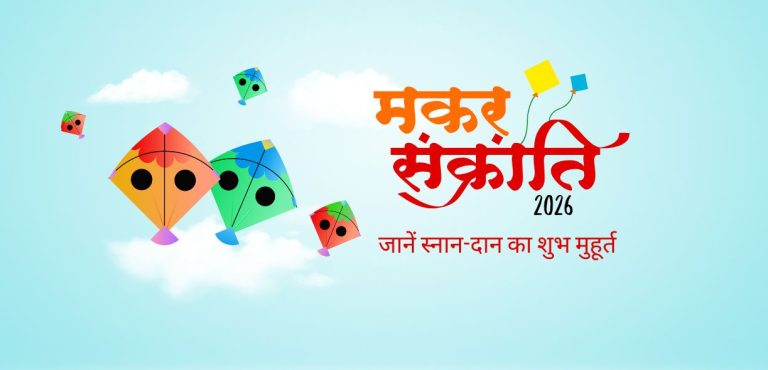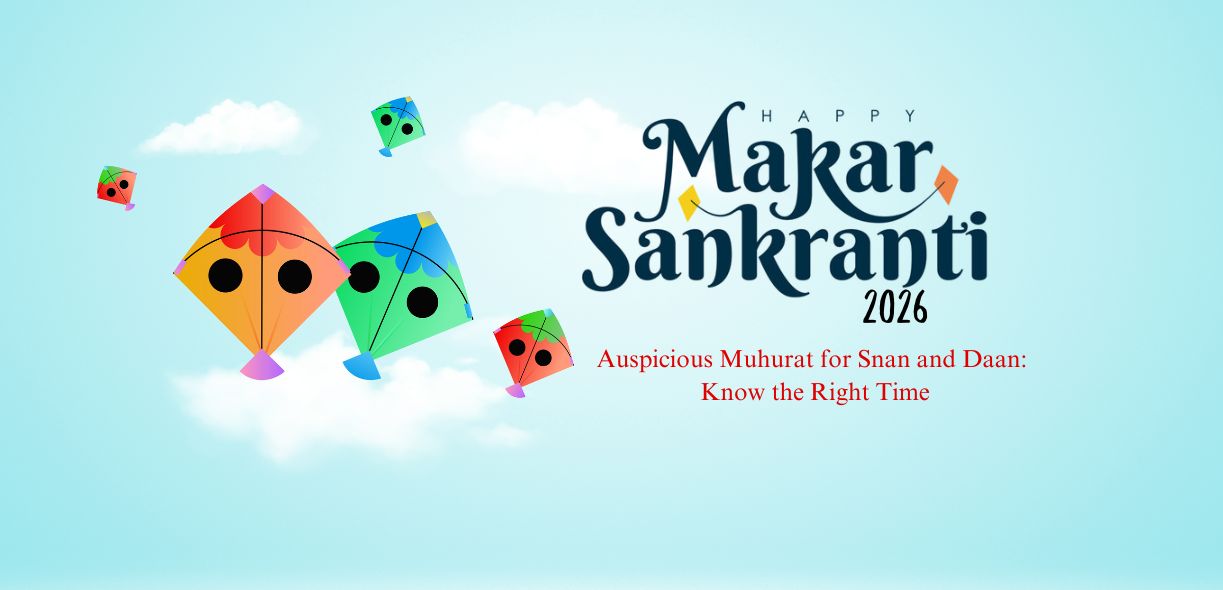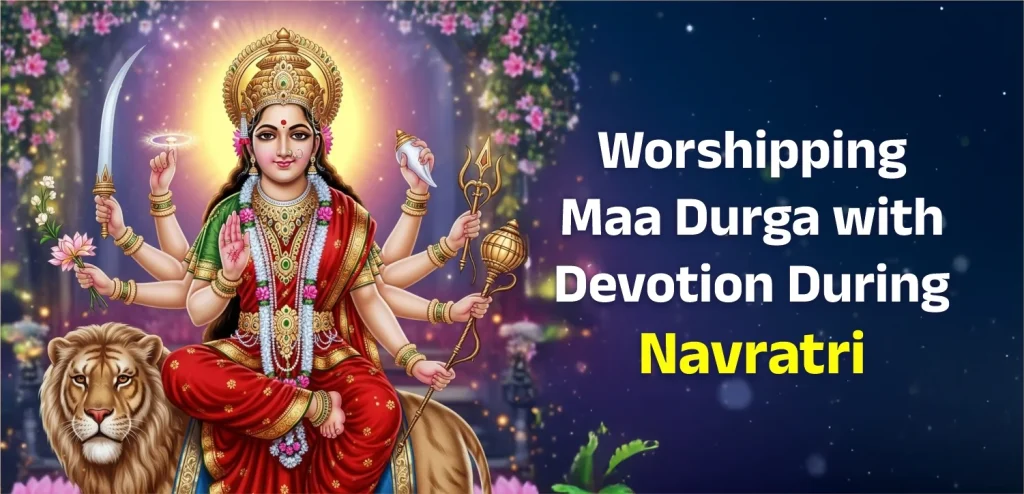As autumn ushers in a season of renewal, India gears up for Navratri 2025, a vibrant nine-night festival celebrating the divine feminine energy—Shakti. This sacred period, steeped in devotion, is not just a religious event but a cultural and spiritual journey. From the rhythmic beats of Gujarat’s garba to Bengal’s grand Durga Puja, this festival unites millions in worship and festivity.
In this comprehensive guide, we explore Navratri 2025 dates, Ghatasthapana Muhurat, the significance of each day, state-wise traditions, charity initiatives like Kanya Pujan, and practical tips to celebrate meaningfully.
What is Navratri, and Why It Is Important?
Navratri, meaning “nine nights” in Sanskrit, is a cornerstone of Sanatan Dharma, honoring Goddess Durga and her nine forms, known as Navdurga. It’s a festival of Shakti Sadhana—spiritual discipline to invoke inner strength—and a celebration of good triumphing over evil, as depicted in the epic battle of Durga against Mahishasura.
According to the Markandeya Purana, this festival occurs four times a year: Chaitra (spring), Ashadha (monsoon), Sharadiya (autumn), and Magh (winter). Among these, Sharadiya Navratri holds unparalleled grandeur, aligning with the harvest season and symbolizing renewal.
Why is Navratri so vital? It transcends mere ritual, offering a holistic detox:
-
Spiritually, it purifies through fasting and mantra chanting, aligning chakras from muladhara to sahasrara.
-
Physically, the sattvic diet (fruits, nuts, buckwheat) boosts immunity, which is ideal for seasonal transitions.
-
Emotionally, communal dances like garba release endorphins, fostering joy.
-
Economically, it fuels local markets with demand for idols, attire, and sweets.
-
Socially, it strengthens bonds, especially for women, empowering them through Shakti’s archetype.
In 2025, amidst a fast-paced world, Navratri offers a pause to reconnect with inner resilience, making it a beacon of hope and empowerment.
Navratri 2025 Dates and Tithi (Ghatasthapana Muhurta)
The Ghatasthapana (earthen pot) for Sharadiya Navratri 2025 will be performed on September 22nd. On this day, devotees can install the Kalash at two auspicious times. The morning Muhurta (earthen pot) will be from 6:09 AM to 8:06 AM, during which invoking Goddess Durga is considered auspicious.
If worship is not possible at these times, devotees can choose the Abhijit Muhurta, which runs from 11:49 AM to 12:38 PM. Performing Ghatasthapana during these two periods bestows special merit and the Goddess’s blessings.
In the below table, the Navratri 2025 schedule (September 22–October 1) is detailed, specifying dates, days, lunar tithis, goddesses, their significance, and corresponding colors for daily worship. It serves as a guide for devotees to perform rituals and choose attire to honor each goddess.
| Date (2025) |
Day |
Tithi (Lunar Day) |
Goddess |
Significance |
Color |
| September 22 |
Day 1 (Monday) |
Pratipada |
Maa Shailputri |
Known as the daughter of the Himalayas, Shailputri governs the muladhara chakra, fostering stability and grounding. Worshipping her sets the foundation for spiritual growth, encouraging discipline and focus. Devotees wear yellow to channel her earthy energy. |
White |
| September 23 |
Day 2 (Tuesday) |
Dwitiya |
Maa Brahmacharini |
The ascetic goddess symbolizes tapas (penance) and wisdom. Her worship strengthens resolve, ideal for students or those seeking clarity in life goals. Green attire reflects her nurturing, forest-like aura. |
Red |
| September 24 |
Day 3 (Wednesday) |
Tritiya |
Maa Chandraghanta |
With her moon-bell adornment, she dispels negativity and fear. Her worship enhances courage and mental peace, perfect for overcoming obstacles. White or grey outfits align with her lunar grace. |
Blue |
| September 25 |
Day 4 (Thursday) |
Chaturthi |
Maa Kushmanda |
The universe’s creator radiates vitality. Her worship boosts health and creativity, energizing devotees for new ventures. Orange attire mirrors her radiant, life-giving power. |
Yellow |
| September 26 |
Day 5 (Friday) |
Panchami |
Maa Skandamata |
Mother of Kartikeya, she nurtures maternal strength and courage. Her worship protects families and fosters leadership. White attire signifies her pure, protective love. |
Green |
| September 27 |
Day 6 (Saturday) |
Shashti |
Maa Katyayani |
The warrior goddess destroys ego and pride. Her worship empowers devotees to face challenges boldly, ideal for professionals or activists. Red attire channels her fierce energy. |
Brown |
| September 28 |
Day 7 (Sunday) |
Saptami |
Maa Kaalratri |
The fierce protector banishes fears and dark energies. Her worship is potent for overcoming personal demons like anxiety. Blue attire reflects her cosmic, transformative power. |
Orange |
| September 29 |
Day 8 (Monday) |
Ashtami |
Maa Mahagauri |
Radiating serenity, she symbolizes forgiveness and purity. Her worship cleanses past karma, bringing peace. Pink attire aligns with her gentle, forgiving nature. (Note: Some regions observe Ashtami on September 30.) |
Parrot Green |
| October 1 |
Day 9 (Wednesday) |
Navami |
Maa Siddhidatri |
Granter of siddhis (spiritual powers), she crowns the sadhana. Her worship unlocks potential, ideal for meditators seeking enlightenment. Purple attire signifies her mystical energy. |
Pink |
Vijayadashami (October 2, Dashami) concludes the festival, celebrating Durga’s triumph over Mahishasura and Rama’s victory over Ravana. These Navratri 2025 dates vary slightly by regional panchangs, but September 22 is the universal start for most of India. Check local almanacs for precise tithi adjustments.
Worship the Nine Forms of Maa Durga
The festival of Navratri holds special significance in Hinduism. It is a divine occasion for devotion, faith, and purification of the soul. By worshiping the nine forms of Goddess Durga during this festival, devotees can remove unrest and negativity from their lives and infuse positive energy and enthusiasm. This festival is not only about devotion and worship but also an opportunity to awaken self-power and self-confidence.
Each day of this festival features a specific form of the Mother Goddess. According to mythology, meditating on and worshipping these nine forms is believed to bring good fortune, health, wealth, and prosperity. Let’s explore which forms of the Mother Goddess should be worshipped on each day of Navratri and their significance.
Day One: Maa Shailputri
The first day of Navratri is dedicated to Maa Shailputri. Shailputri means daughter of the mountain. This form of Maa Amba symbolizes strength and courage. Shailputri is a form of Maa Parvati, who showers compassion and blessings upon her devotees. Fasting and worshipping her on this day develops mental and physical strength.
Second Day: Maa Brahmacharini
On the second day, Maa Brahmacharini is worshipped. This form symbolizes meditation and knowledge. Devotion to Maa Brahmacharini brings peace of mind, increased knowledge, and spiritual progress. Worshiping her bestows patience and self-control upon the soul.
Third Day: Maa Chandraghanta
On the third day, Maa Chandraghanta is worshipped. This form symbolizes fearlessness. Maa Chandraghanta is believed to conquer enemies and dispel fear. Meditating and worshipping her on this day instills courage and self-confidence in life.
Fourth Day: Maa Kushmanda
On the fourth day of Navratri, Maa Kushmanda is worshipped. This form of Maa Goddess symbolizes the power of creation. With the blessings of Maa Kushmanda, positive energy flows into life. Meditating on her brings enthusiasm to the soul and new energy to life.
Fifth Day: Skandamata
On the fifth day, Goddess Skandamata is worshipped. This form symbolizes compassion and motherly devotion. Skandamata bestows happiness and prosperity and protects children in the lives of her devotees. Worshiping her bestows the Goddess’s blessings and fosters harmony and love in the family.
Sixth Day: Maa Katyayani
On the sixth day of Navratri, Maa Katyayani is worshipped. This form symbolizes bravery and the power of struggle. Maa Katyayani destroys negative forces and provides protection to her devotees. Worshiping her develops courage, patience, and self-reliance in life.
Seventh Day: Maa Kaalratri
On the seventh day, Maa Kaalratri is worshipped. This form of the Mother Goddess eliminates fear and ignorance. Maa Kaalratri protects her devotees from all troubles and negative forces. Worshiping her destroys fear and depression and increases self-confidence in life.
Eighth Day: Maa Mahagauri
On the eighth day, Maa Mahagauri is worshipped. This form symbolizes beauty and compassion. Mahagauri removes suffering and disease from the lives of her devotees. Worshiping her brings mental peace and bodily energy.
Ninth Day: Maa Siddhidatri
The last day of Navratri is dedicated to Mother Siddhidatri. This form bestows all accomplishments and blessings. Worshiping Maa Siddhidatri brings happiness, prosperity, and spiritual progress in life. This day is considered a symbol of Mother’s complete blessings.
Worshiping these nine divine forms of Navratri not only brings feelings of devotion and reverence but also positive changes, spiritual progress, and mental peace in life. Meditating on a specific form of the Mother Goddess each day destroys sorrow and negativity in life and brings blessings.
This holy Festival, worship these nine forms of Mother Goddess and illuminate your life with happiness, peace, and prosperity. May your life always be auspicious and full of divine experiences by the grace of Mother Goddess.
Religious Significance of Navratri
The scriptures describe Navratri as a festival of worshipping Shakti. The Markandeya Purana and Durga Saptashati describe that whenever the spread of unrighteousness increased, Goddess Bhagwati assumed various forms and destroyed the demons.
By killing demons like Mahishasura, Shumbha-Nishumbha, and Chand-Mund, the Mother Goddess protected Dharma. For this reason, this festival is considered a festival symbolizing the victory of Dharma and the destruction of Adharma.
The nine days of Navratri are dedicated to the nine forms of the Mother Goddess: Shailputri, Brahmacharini, Chandraghanta, Kushmanda, Skandamata, Katyayani, Kaalratri, Mahagauri, and Siddhidatri. Each day has its own color, ritual, and worship method, in which the Mother Goddess is worshipped in nine different forms.
State-Wise Importance and Celebrations of Navratri
Navratri’s charm lies in its regional diversity, each state weaving unique traditions into the festival’s fabric:
Gujarat
- The garba capital, hosting UNESCO-recognized dandiya nights.
- Significance: Celebrates post-monsoon fertility; Ahmedabad’s mega-venues draw global crowds, blending folk with fusion music.
- Wear vibrant chaniya cholis for authenticity.
West Bengal
- Durga Puja reigns supreme, with pandals showcasing eco-themes.
- Importance: Reflects matriarchal heritage; Kolkata’s 40,000 idols immerse in the Hooghly, symbolizing renewal.
Maharashtra
- Mumbai’s Juhu garba meets rural ladi dances.
- Role: Unites urban-rural communities; Pune’s ayudha puja honors tools, tying to trade prosperity.
Rajasthan
- Jaipur’s palace jhankis and Udaipur’s lake aartis.
- Essence: Embodies Rajput valor; emphasizes water conservation in arid regions.
Tamil Nadu:
- Bommai Kolu displays narrate epics.
- Significance: Promotes knowledge and gender equality; Chennai’s 108-step kolus inspire creativity.
Punjab:
- Dhol-driven bhangra garba at Amritsar’s langars.
- Weight: Fosters seva; celebrates resilience against oppression.
Odisha:
- Chhau dances reenact Durga’s battles.
- Pivot: Integrates tribal lore with Jagannath traditions.
Kerala:
- Vidyarambham and Saraswati puja.
- Core: Honors intellectual Shakti; Thrissur’s processions blend Onam vibes.
Uttar Pradesh:
- Ayodhya’s Ramlila ties to Dussehra.
- Focus: Spiritual-political synergy; Varanasi’s ghats purify souls.
Assam:
- Kamakhya’s tantric rituals empower women artisans.
- Essence: Weaves Bihu into bhakti.
These variations make Navratri 2025 a cultural mosaic, uniting India’s 1.4 billion in devotion.
Navratri Puja Vidhi 2025
- Bath in the morning and wear clean clothes.
- Purify the place of worship with Ganga water and create an altar by placing a wooden plank on it.
- Install a Kalash (pot) containing water, betel nut, a coin, five gems, and mango leaves.
- Place a coconut wrapped in a clean red cloth on top of the Kalash.
- Sow barley or wheat in the soil near the pot and install an idol or picture of Goddess Durga.
- Worship Goddess Ambe with a lamp, incense, flowers, rice grains, and offerings.
- Recite Durga Saptashati.
- For nine days, perform aarti for the Mother Goddess morning and evening and offer her offerings.
The Importance of Charity During Navratri
The festival of Navratri is considered an auspicious time for service, philanthropy, and charity. Religious texts state that donations made during these nine days of this festival bestow eternal merit. This divine opportunity to receive the blessings of Goddess Durga not only brings spiritual peace to devotees but also brings happiness and prosperity into their lives.
Especially on the eighth and ninth days, worshipping girls, feeding them, and offering them clothes and offerings of alms is considered highly virtuous. Kanya pujan involves worshipping the form of Goddess Durga and is believed to alleviate the devotee’s suffering and bring good fortune to their families.
Worship of Specially Abled Girls
This Navratri, the Narayan Seva Sansthan is undertaking a unique service. The organization will perform Kanya Pujan for 501 innocent, specially abled girls. On this auspicious occasion, the girls will be worshipped, considered to be embodiments of Goddess Amba, and will be draped with a scarf. They will also be offered delicious prasad and food.
To give these girls a new lease of life, the organization is also pledging to perform free surgeries on them and make them physically able. This service project will not only bring new light into the lives of the girls, but every donor who contributes will also be worthy of the infinite blessings of Goddess Durga.
The Spiritual Message of Navratri
Navratri is an excellent opportunity for self-purification and divine grace. This festival gives us the message of strength, restraint, and devotion. When a devotee worships Goddess Durga with a true heart, negativity is eliminated from their lives, and the path to happiness and prosperity opens.
Ya Devi Sarvabhuteshu Matrurupen Samsthita.
Namastasyai Namastasyai Namastasyai Namo Namah.







